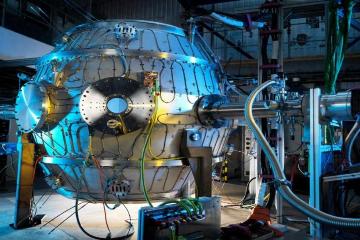On December 5, the American Department of Energy and the UK’s Department for Energy Security and Net Zero jointly announced a significant investment of $52 million into Tokamak Energy, a British nuclear fusion companyThis financial commitment aims to enhance the ST40 experimental fusion facility, marking a pivotal step toward deeper collaborative efforts in advancing fusion energy technology.
Fusion energy is increasingly recognized as a crucial alternative in the pursuit of clean energyUnlike conventional energy sources that contribute to greenhouse gas emissions and generate long-lived radioactive waste, fusion holds the promise of producing a sustainable energy supply devoid of those concernsIf harnessed effectively on Earth, fusion has the potential to offer humanity a safe, clean, and virtually limitless energy source.
Kerry McCarthy, the UK’s Climate Minister, emphasized the transformative potential of fusion energy, stating that it could fundamentally alter how we generate electricity
Advertisements
She underscored the importance of this strategic collaboration in expediting the development of this promising technology.
Tokamak Energy has distinguished itself as a leader in the fusion energy sectorWith over a decade of experience in the design, construction, and operation of Tokamak devices, it stands out as the only private enterprise with such an extensive track recordEstablished in 2009 from the UK Atomic Energy Authority, the company has risen to become one of Europe’s most formidable private fusion energy firms.
The company’s ST40 device has already achieved remarkable milestones in partnership with notable institutions such as Princeton Plasma Physics Laboratory and Oak Ridge National Laboratory, reaching plasma temperatures six times hotter than the Sun’s core
Advertisements
This accomplishment marked ST40 as the first privately-operated fusion reactor to reach the impressive temperature of 100 million degrees Celsius.
One of the essential innovations in the upcoming upgrade project will focus on applying a lithium coating on the inner walls of the ST40 deviceThis technological advancement, which traces its roots back to the 1990s, is anticipated to significantly enhance the reactor's performance and stabilitySteven Cowley, director of the Princeton Plasma Physics Laboratory, remarked on the pioneering use of lithium coatings in fusion devices initiated decades ago, expressing excitement at the prospect of collaborating with private enterprises to put this expertise into practice.
Warrick Matthews, CEO of Tokamak Energy, expressed enthusiasm for the future trajectory of the ST40, acknowledging its impressive accomplishments over recent years and the significance of this public-private partnership for advancing its next mission
Advertisements
The project is poised to encourage the development of spherical Tokamak technology and further the overall scientific and technological progress of the fusion energy industry.
For the controlled nuclear fusion to become a reality, the U.SDepartment of Energy has set forth three critical conditions that must be satisfied: the plasma fuel particles need to achieve sufficiently high temperatures, reach adequate density, and maintain their heat for a sufficiently long periodMeeting these demanding parameters represents a substantial hurdle in the commercialization of fusion energy.
This ambitious five-year project is expected to commence in 2025, with the three parties collaborating on the allocated $52 million fundingThe upgraded facility is projected to be operational by 2027, marking a significant milestone in the field of fusion energy.
Moreover, the implications of this cooperation extend beyond mere technological innovation, fostering deeper international research collaboration
- Han's M&A Faces Hurdles in Hong Kong
- 2024: A Milestone Year for AI
- Polysilicon Production Cuts to Impact PV Market
- Western Chip Firms Double Down on China
- Hong Kong Dividend Plays Offer Value
Under the agreement, researchers from U.Suniversities and national laboratories stand to benefit from the research conducted at the ST40 Tokamak deviceThis openness and sharing of knowledge are critical for accelerating breakthroughs in fusion energy technology.
Tokamak Energy's ambitious development strategy aims to construct another spherical Tokamak prototype, known as the ST80-HTS, by 2026 at the Culham Centre for Fusion EnergyThis prototype will showcase the full potential of high-temperature superconducting magnetsThe overarching goal is to establish a prototype grid-connected fusion power plant by the 2030s and ultimately develop commercial reactors capable of producing 500 megawatts of power—enough to power approximately 85,000 homes.
Recent design plans disclosed by Tokamak Energy unveil the development of a high-field spherical Tokamak plant, estimated to generate 800 megawatts of fusion power and yield 85 megawatts of net electrical output

This next-generation device will leverage high-temperature superconducting magnets to confine and control deuterium-tritium fuels, facilitating plasma temperatures that significantly exceed those of the Sun's core.
The specifications for this sophisticated device include a 2.0 aspect ratio, a 4.25-meter plasma major radius, and a magnetic field strength of 4.25 Tesla, complemented by a liquid lithium-tritium breeding blanketAchieving these technical benchmarks would signify a historical advancement in fusion energy capabilities.
This collaboration forms a crucial part of the fusion strategic partnership signed by the United States and the UK in December 2023, aiming to propel the United States' "Bold Decadal Vision for Commercial Fusion Energy" and the UK's fusion strategy forward.
Tokamak Energy has already demonstrated formidable fundraising capabilities, amassing over $335 million in total funding, reinforcing its status as one of Europe’s most well-funded private fusion energy firms